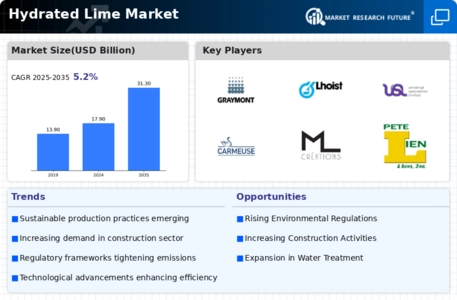Market Analysis
In-depth Analysis of Hydrated Lime Market Industry Landscape
The hydrated lime market operates within a dynamic framework influenced by various factors that impact production, distribution, and demand dynamics. Hydrated lime, also known as calcium hydroxide, is a versatile chemical compound used in various industrial applications, including construction, water treatment, agriculture, and manufacturing. Understanding the market dynamics of hydrated lime involves analyzing key elements such as raw material availability, manufacturing processes, end-user industries, regulatory policies, and competitive forces.
Raw material availability and pricing play a significant role in shaping the dynamics of the hydrated lime market. Limestone, the primary raw material used in hydrated lime production, is abundant globally, with varying grades and qualities available depending on geological conditions. Fluctuations in limestone reserves, mining activities, and transportation costs can impact raw material availability and pricing, affecting production costs for hydrated lime manufacturers. Additionally, factors such as energy prices, labor costs, and environmental regulations further influence production costs and pricing dynamics in the hydrated lime market.
Manufacturing processes and technological advancements drive efficiency and innovation in the hydrated lime industry. Hydrated lime is typically produced by hydrating quicklime (calcium oxide) with water, a process known as slaking. Advancements in slaking technologies, such as hydration reactors and continuous slaking systems, have led to improvements in production efficiency, product quality, and environmental performance. These advancements enable hydrated lime manufacturers to optimize production processes, reduce energy consumption, and minimize environmental impacts, aligning with sustainability goals and regulatory requirements.
End-user industries and application trends are key drivers of demand dynamics in the hydrated lime market. Hydrated lime finds applications in various sectors, including construction (mortar and plaster), water treatment (alkalinity adjustment and pH control), agriculture (soil stabilization and crop protection), and manufacturing (chemical processing and metallurgy). The demand for hydrated lime is influenced by factors such as infrastructure development, water quality regulations, agricultural practices, and industrial activity. For example, increasing construction activities in emerging economies drive demand for hydrated lime in mortar and plaster applications, while stringent environmental regulations spur demand for hydrated lime in water treatment and air pollution control.
Regulatory policies and environmental regulations shape market dynamics by influencing product quality standards, safety requirements, and environmental compliance. Governments worldwide enact regulations aimed at ensuring the safe handling, storage, and use of hydrated lime products, as well as mitigating environmental impacts associated with production and application. Compliance with regulatory requirements is essential for hydrated lime manufacturers to maintain market access, enhance product credibility, and mitigate potential liabilities. Additionally, sustainability initiatives and green procurement policies encourage the adoption of environmentally friendly lime products, driving market demand for sustainable solutions.
Competitive forces drive market dynamics by influencing pricing strategies, product differentiation, and market share. The hydrated lime market is characterized by a diverse array of suppliers, including multinational corporations, regional manufacturers, and specialty lime producers. Intense competition prevails due to factors such as product quality, supply chain efficiency, and customer relationships. Companies compete for market share by offering innovative products, expanding product portfolios, and leveraging distribution networks. Moreover, strategic alliances, mergers, and acquisitions play a crucial role in expanding market presence and gaining a competitive edge in the hydrated lime industry.


 Source: Secondary Research, Primary Research, Market Research Future Database and Analyst Review
Source: Secondary Research, Primary Research, Market Research Future Database and Analyst Review








Leave a Comment